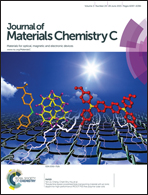Synthesis of nitrogen-doped monolayer graphene with high transparent and n-type electrical properties†
Abstract
A one-step synthesis of a large-area and highly nitrogen-doped graphene (NG) membrane with few defects derived from poly 4-vinyl pyridine (P4VP) has been reported. The synthesis temperature has been optimized by Raman spectroscopy and X-ray photoelectron spectroscopy (XPS). With this approach, a large-area of more than 80% single-layer NG membrane with a nitrogen content of 6.37% can be obtained. Scanning electron microscopy (SEM), atomic force microscopy (AFM), Raman mapping-mode, optical microscopy (OM) and transmission electron microscopy (TEM) analyses reveal that the resultant NG is a flat, continuous, uniform and monolayered graphene membrane with a large area and a well-ordered crystalline structure. The electrical measurement confirms the typical n-type field-effect transistors (FETs) for NG both in air and vacuum, and the electron mobility can reach as high as 365 cm2 V−1 s−1, much higher than those of NGs previously reported. In addition, the transmittance and sheet resistance of NG correlates well with a monolayered structure and semiconducting properties, which also makes it a candidate of transparent electrode for various optoelectronic devices.


 Please wait while we load your content...
Please wait while we load your content...